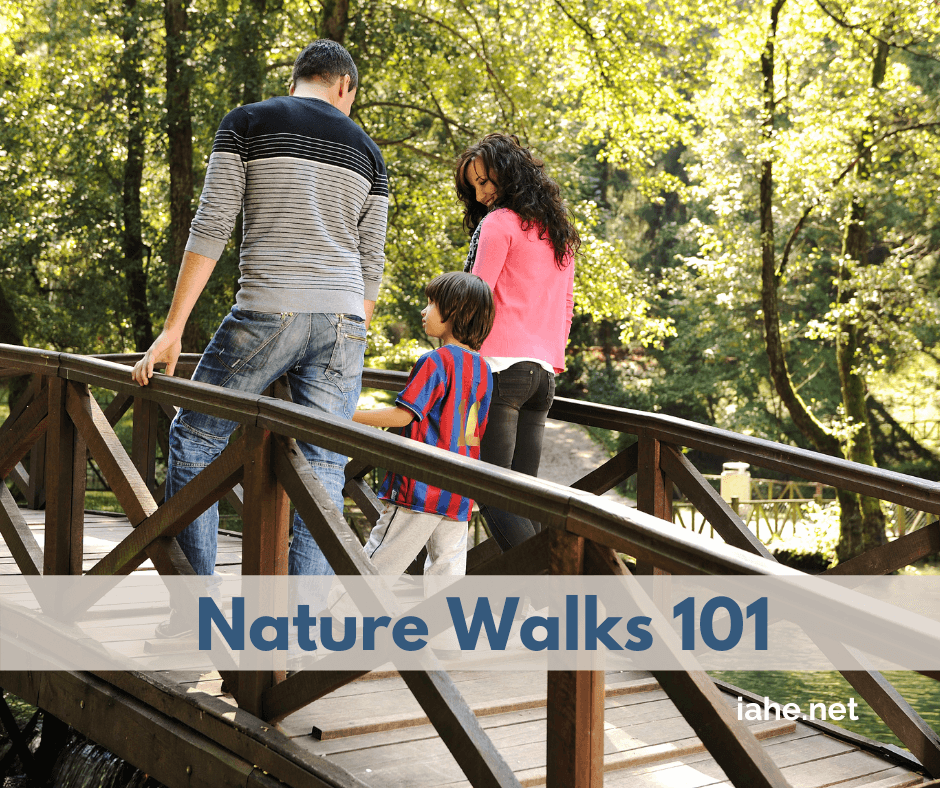Nature Walks 101

Nature walks are an easy and fun way to teach your children observational science skills, study earth science, and get some exercise!
What is a ‘Nature Walk’?
Simply put, it’s going outdoors to observe or experience a particular aspect of nature.
That’s it? It Feels Like There Should Be More.
At bare minimum, all a nature walk entails is going outside and observing through the five senses: What do you see? What do you hear? What do you smell? What can you touch? What do you taste? (Note: tasting things in nature is not recommended unless you are absolutely sure the object is safe to ingest. When in doubt, do not eat things no matter how edible they look.)
What Are the Best Ages for Nature Walks?
All ages, from babies to teenagers, benefit from regular exploration outdoors. Young children observe their natural world to explore and engage the senses, see patterns and colors, and observe varieties of animals and birds and weather patterns. Older children can learn cardinal directions, early mapping skills, geography, deeper understanding of weather, and specific species of birds, animals, trees, flowers, fish, and other living things. Teenagers can specialize in specific bird or tree or flower species for an in-depth study, or conduct weather experiments, and build a sense of direction and understanding of landforms and terrains.
What Kind of Equipment Do I Need?
Comfortable walking shoes and a water bottle, at the least. Hats and sunscreen for sunny days. A small nature walk bag can help enhance any interesting finds along the way.
Consider adding:
- binoculars
- tweezers
- clear specimen cups
- handheld magnifying glass
- minnow net
- Compass
- first aid kit
- local field guides
Older children may enjoy bringing along a nature journal and pencils or watercolors to sketch objects of interest. Notebooking can be difficult with littles in tow, so consider leaving the books and pencils at home when you walk with younger children, and instead focus on individual topics to spot on the walk. If you like, journal when you get home.
How Do I Decide What To Look For?
- Spring: look for budding trees, nesting birds, spring flowers, rain, and changes in wind direction.
- Summer: birds and wildlife, insects, tree leaves, flowers, clouds, temperature, stars and moon, and water life.
- Fall: nuts and seeds, migrating animals and birds, dying plants and roots, wind and heat changes, storms, rocks and stones, burrowing insects and animals.
- Winter: snow and ice, frozen rivers and ponds, winter burrows and nests, winter food supplies, temperature, animal tracks.
There are also many nature walk curricula that have pre-set topics to help you get started.
I’m Not Outdoorsy. What Can I Do To Feel More Comfortable Venturing Into Nature With My Kids?
Knowing where you’re going and what you may encounter (weather, trail conditions, bugs, wildlife) and how to deal with those things are the first steps toward getting into a habit of enjoying the outdoors. Investing in quality gear also goes a long way toward making one feel confident in nature. Check out these points below to help you prepare.
- Know where bugs and wildlife live, and what kinds you may encounter on your walk. Woods and trees may have more ticks and spiders, cool shaded streams can draw snakes and mosquitos in hot summer, open fields might be prone to ground bees, wasps, and snakes. Observe your surroundings, and know where you are walking. If you’re unsure of an off-trail area, stay on the path. Know what to do if you encounter snakes, bees, or dangerous wildlife. If you get stung or bit, have a first aid kit on hand or at least in your car. When you get home from a walk, do a quick tick-check of coats, collars, sleeve and pant cuffs. Being knowledgeable about where bugs live and how they move can make you feel more confident about meeting them as you venture out into nature.
- Bug repellant. Ticks, mosquitos, and other friends are part of nature. You can’t avoid them, but you can protect yourself against those that pose true health risks. There are many types of bug repellants, from traditional sprays to all-natural oils and creams. You can also use light-weight long-sleeve rashguards, hats with veils, long pants and socks, and closed-toe-shoes to protect yourself from unwanted pests.
- Sunscreen. And hats. Both together are necessary for health and safety. Look for a broad-spectrum sunscreen. For sensitive skin, there are many hypoallergenic mineral-based sunscreens available on the market. Long-sleeve rash-guards can also protect against the sun. Lightweight hats keep the sun of your head. Some have detachable neck flaps for added coverage.
- First Aid Kit. You don’t need the entire Red Cross. A simple, well-stocked trail kit will do for your pack, and you can keep a larger kit in your car. Band-aids, antiseptic cream, bee sting ointment, a one-time use ice pack, and alcohol wipes or hand sanitizer are the most basic kit that can usually address most light trail injuries like scraps, splinters, or bug sting. Take into account allergies like pollen, weeds, and bee stings as you pack your first aid kit.
- Shoes that can get dirty, stout hiking boots, snow boots, and rain boots mean you’re prepared for any kind of weather.
- If you’re prone to cold, look for warm wool or wool-blend base layers. These thin underclothes offer warmth and breathability even in the cold. Look for quality water-proof or water-resistant winter coats. Fleece-lined hats that snugly cover ears, cashmere or wool blend scarves, and waterproof fleece-lined gloves keep hands warm.
- Water-proof, lined winter boots, and water-resistant lined snow pants or medium-weight hiking pants are also good to consider.
- Rain boots, slickers with hoods and cuffed or elastic linings keep everyone dry. A collapsible umbrella that fits into your hiking bag on questionable days can be a lifesaver!
- Water. Water backpacks, rather than water-bottles, are convenient ways to carry water on a hot day. Even littles can wear a water pack, lightening the load for Mom or Dad to carry. There are many options available at varying price-points.
Ok, I’m Convinced! We’re Going On Our First Nature Walk Today!
Congratulations! Enjoy watching your children’s wonder and fascination as they explore our beautiful, amazing world!
